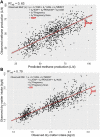Eating Time as a Genetic Indicator of Methane Emissions and Feed Efficiency in Australian Maternal Composite Sheep
- PMID: 35646089
- PMCID: PMC9130857
- DOI: 10.3389/fgene.2022.883520
Eating Time as a Genetic Indicator of Methane Emissions and Feed Efficiency in Australian Maternal Composite Sheep
Abstract
Previous studies have shown reduced enteric methane emissions (ME) and residual feed intake (RFI) through the application of genomic selection in ruminants. The objective of this study was to evaluate feeding behaviour traits as genetic indicators for ME and RFI in Australian Maternal Composite ewes using data from an automated feed intake facility. The feeding behaviour traits evaluated were the amount of time spent eating per day (eating time; ETD; min/day) and per visit (eating time per event; ETE; min/event), daily number of events (DNE), event feed intake (EFI; g/event) and eating rate (ER; g/min). Genotypes and phenotypes of 445 ewes at three different ages (post-weaning, hogget, and adult) were used to estimate the heritability of ME, RFI, and the feeding behaviour traits using univariate genomic best linear unbiased prediction models. Multivariate models were used to estimate the correlations between these traits and within each trait at different ages. The response to selection was evaluated for ME and RFI with direct selection models and indirect models with ETE as an indicator trait, as this behaviour trait was a promising indicator based on heritability and genetic correlations. Heritabilities were between 0.12 and 0.18 for ME and RFI, and between 0.29 and 0.47 for the eating behaviour traits. In our data, selecting for more efficient animals (low RFI) would lead to higher methane emissions per day and per kg of dry matter intake. Selecting for more ETE also improves feed efficiency but results in more methane per day and per kg dry matter intake. Based on our results, ETE could be evaluated as an indicator trait for ME and RFI under an index approach that allows simultaneous selection for improvement in emissions and feed efficiency. Selecting for ETE may have a tremendous impact on the industry, as it may be easier and cheaper to obtain than feed intake and ME data. As the data were collected using individual feeding units, the findings on this research should be validated under grazing conditions.
Keywords: eating time; feed efficiency; methane production; methane yield; residual methane.
Copyright © 2022 Sepulveda, Muir, Bolormaa, Knight, Behrendt, MacLeod, Pryce and Daetwyler.
Conflict of interest statement
The authors declare that the research was conducted in the absence of any commercial or financial relationships that could be construed as a potential conflict of interest.
Figures



Similar articles
-
More feed efficient sheep produce less methane and carbon dioxide when eating high-quality pellets.J Anim Sci. 2017 Sep;95(9):3839-3850. doi: 10.2527/jas2017.1499. J Anim Sci. 2017. PMID: 28992015
-
Phenotypic association among performance, feed efficiency and methane emission traits in Nellore cattle.PLoS One. 2021 Oct 14;16(10):e0257964. doi: 10.1371/journal.pone.0257964. eCollection 2021. PLoS One. 2021. PMID: 34648502 Free PMC article.
-
Genetic parameters for residual feed intake, methane emissions, and body composition in New Zealand maternal sheep.Front Genet. 2022 Aug 16;13:911639. doi: 10.3389/fgene.2022.911639. eCollection 2022. Front Genet. 2022. PMID: 36051695 Free PMC article.
-
A systematic review and meta-analysis: relationship between residual feed intake and traits related to methane emissions in cattle.Trop Anim Health Prod. 2025 Apr 14;57(3):171. doi: 10.1007/s11250-025-04423-6. Trop Anim Health Prod. 2025. PMID: 40227437
-
Genomic selection for feed efficiency in dairy cattle.Animal. 2014 Jan;8(1):1-10. doi: 10.1017/S1751731113001687. Epub 2013 Oct 16. Animal. 2014. PMID: 24128704 Review.
Cited by
-
Associations between a range of enteric methane emission traits and performance traits in indoor-fed growing cattle.J Anim Sci. 2024 Jan 3;102:skae346. doi: 10.1093/jas/skae346. J Anim Sci. 2024. PMID: 39514767 Free PMC article.
References
-
- Allden W., Mcdwhittaker I. (1970). The Determinants of Herbage Intake by Grazing Sheep: The Interrelationship of Factors Influencing Herbage Intake and Availability. Aust. J. Agric. Res. 21, 755. 10.1071/ar9700755 - DOI
-
- Amarilho-Silveira F., de Barbieri I., Cobuci J. A., Balconi C. M., de Ferreira G. F., Ciappesoni G. (2022). Residual Feed Intake for Australian Merino Sheep Estimated in Less Than 42 Days of Trial. Livest. Sci. 258, 104889. 10.1016/j.livsci.2022.104889 - DOI
-
- Arthur P. R., Archer J. A., Herd R. M., Melville G. J. (2001). “Response to Selection for Net Feed Intake in Beef Cattle,” in Proc. Assoc. Advmt. Anim. Breed. Genet. Queenstown, New Zealand 14, 135–138.
LinkOut - more resources
Full Text Sources
Research Materials

